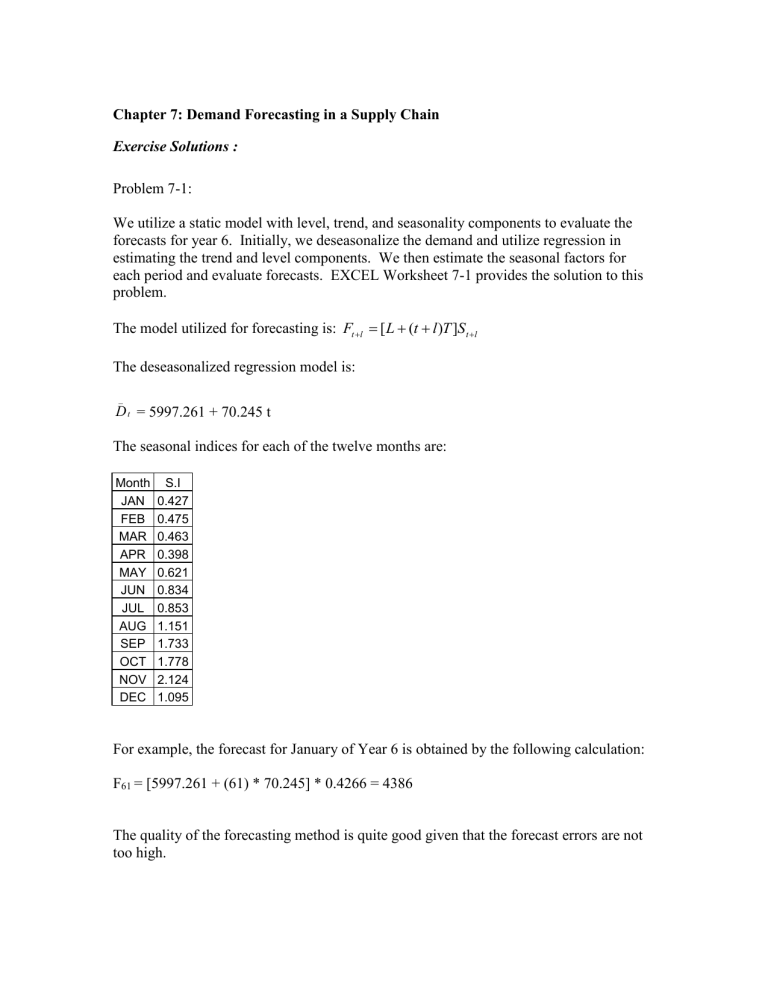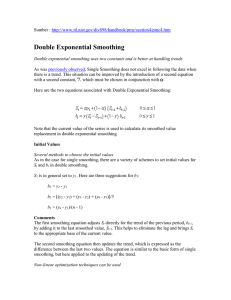
Chapter 7: Demand Forecasting in a Supply Chain
Exercise Solutions :
Problem 7-1:
We utilize a static model with level, trend, and seasonality components to evaluate the forecasts for year 6. Initially, we deseasonalize the demand and utilize regression in estimating the trend and level components. We then estimate the seasonal factors for each period and evaluate forecasts. EXCEL Worksheet 7-1 provides the solution to this problem.
The model utilized for forecasting is: F t
l
[ L
( t
l ) T ] S t
l
The deseasonalized regression model is:
_
D t
= 5997.261 + 70.245 t
The seasonal indices for each of the twelve months are:
Month S.I
JAN 0.427
FEB 0.475
MAR 0.463
APR 0.398
MAY 0.621
JUN 0.834
JUL 0.853
AUG 1.151
SEP 1.733
OCT 1.778
NOV 2.124
DEC 1.095
For example, the forecast for January of Year 6 is obtained by the following calculation:
F
61
= [5997.261 + (61) * 70.245] * 0.4266 = 4386
The quality of the forecasting method is quite good given that the forecast errors are not too high.
Problem 7-2:
Worksheet 7-2 compares the four-week moving average approach with the exponential smoothing model (alpha = 0.1). In a four-week moving average model the weight assigned to the most recent data is 0.25 whereas in the case of the exponential smoothing model the weight assigned is 0.1. The following graphs depict the results from the two models.
Moving Average
130
Actual Demand Forecasted Demand
120
110
100
90
80
1 2 3 4 5 6 7 8 9 10 11 12 13 14 15 16
Periods
EXPONENTIAL SMOOTHING
Actual Demand Forecasted Demand
130
125
120
115
110
105
100
95
90
85
80
1 2 3 4 5 6 7 8 9 10 11 12 13 14 15 16
Periods
For this specific problem, it is evident that the moving average model is more responsive than the exponential smoothing approach due the difference in weights allocation (0.25 and 0.1). Using MAD as a measure for forecast accuracy it can be concluded that the moving average model (MAD = 9) is slightly more accurate than the exponential smoothing model (MAD = 10) in evaluating forecasts.
Example 7-3:
The simple exponential smoothing model only considers the level component and does not include a trend component in the analysis. However, Holt’s model allows for the incorporation of the trend component into the analysis. Worksheet 7-3 provides the results of the two approaches.
200
180
160
140
120
100
80
60
40
20
0
P1 P2 P3 P4 P5 P6 P7 P8 P9 P10 P11 P12 P13 P14 P15 P16
Period
By investigating the relationship between sales and period (shown in the above graph) it is evident that the data exhibits both random fluctuation and trend. Thus, it is not surprising in the analysis that Holt’s model (alpha = 0.1, beta = 0.1, MAD = 8) is a better approach than the simple exponential smoothing model (alpha = 0.1, MAD = 21).
Example 7-4:
Worksheet 7-4 evaluates demand forecasts for the ABC Corporation using moving average, simple exponential smoothing, Holt’s model, and Winter’s model. Note that solver is utilized for simple exponential smoothing, Holt’s and Winter’s models in determining the optimal values for the smoothing constants by minimizing the MAD subject to the constraint that the smoothing constant values are < 1.
It is evident that Winter’s model is preferable in this case with the lowest MAD value, i.e., lowest forecast error. It is also important to note that Winter’s model allows for the incorporation of level, trend and seasonality, which are evident in the demand data for this case.


